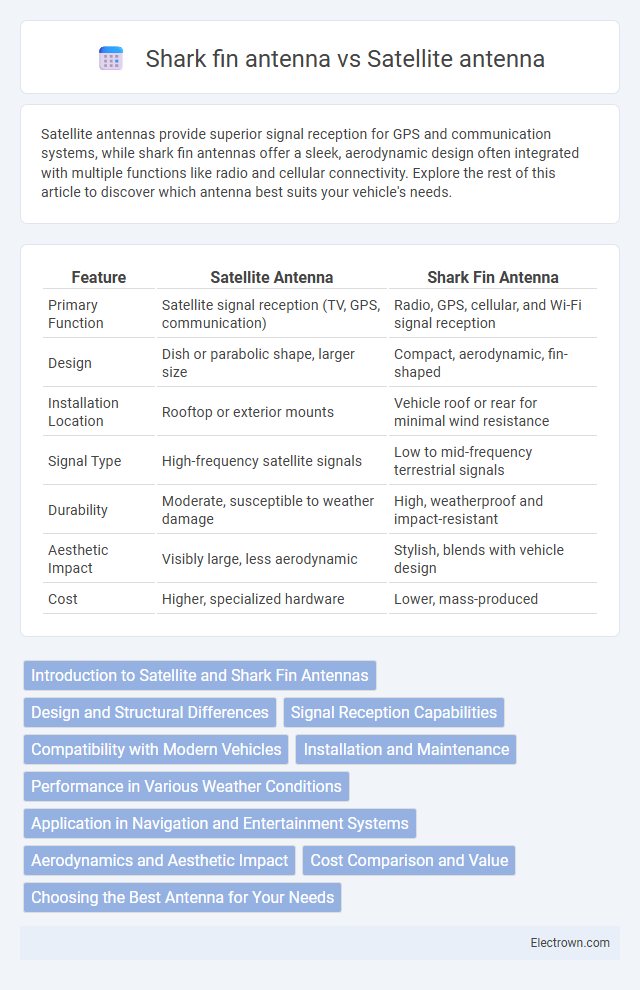Satellite antennas provide superior signal reception for GPS and communication systems, while shark fin antennas offer a sleek, aerodynamic design often integrated with multiple functions like radio and cellular connectivity. Explore the rest of this article to discover which antenna best suits your vehicle's needs.
Table of Comparison
| Feature | Satellite Antenna | Shark Fin Antenna |
|---|---|---|
| Primary Function | Satellite signal reception (TV, GPS, communication) | Radio, GPS, cellular, and Wi-Fi signal reception |
| Design | Dish or parabolic shape, larger size | Compact, aerodynamic, fin-shaped |
| Installation Location | Rooftop or exterior mounts | Vehicle roof or rear for minimal wind resistance |
| Signal Type | High-frequency satellite signals | Low to mid-frequency terrestrial signals |
| Durability | Moderate, susceptible to weather damage | High, weatherproof and impact-resistant |
| Aesthetic Impact | Visibly large, less aerodynamic | Stylish, blends with vehicle design |
| Cost | Higher, specialized hardware | Lower, mass-produced |
Introduction to Satellite and Shark Fin Antennas
Satellite antennas use parabolic or flat-panel designs to receive signals from orbiting satellites, providing reliable GPS, radio, and internet connectivity. Shark fin antennas feature a compact, aerodynamic shape housing multiple functions such as GPS, cellular, and radio receivers in one unit, reducing drag and enhancing vehicle aesthetics. Your choice depends on the need for multi-functionality and design preferences, with satellite antennas excelling in signal strength and shark fin antennas offering streamlined integration.
Design and Structural Differences
Satellite antennas feature a larger, often cylindrical or parabolic design optimized for signal reception, while shark fin antennas are compact, streamlined, and resemble a shark's dorsal fin for aesthetic integration. The satellite antenna's structure includes components like a reflector and feed horn to capture satellite signals, whereas the shark fin houses multiple smaller antennas, including GPS, cellular, and radio modules, within a unified aerodynamic shell. The shark fin design reduces wind resistance and improves vehicle appearance, while the satellite antenna prioritizes signal strength and range.
Signal Reception Capabilities
Satellite antennas provide superior signal reception capabilities due to their ability to capture signals from specific satellites with high precision, often enabling consistent connectivity in remote or obstructed areas. Shark fin antennas combine multiple functionalities such as GPS, radio, and cellular signals but generally offer moderate reception quality compared to dedicated satellite antennas. The design and technology of satellite antennas prioritize enhanced signal gain and reduced interference, making them ideal for applications requiring reliable, long-range communication.
Compatibility with Modern Vehicles
Satellite antennas offer broad compatibility with a wide range of modern vehicles, especially those equipped with advanced infotainment systems and satellite radio services, enhancing signal reception for GPS, satellite radio, and telematics. Shark fin antennas have become increasingly popular in contemporary car designs due to their compact size and aerodynamic shape, providing integrated functionality for cellular, GPS, and radio signals while seamlessly blending with vehicle aesthetics. Manufacturers often prefer shark fin antennas for electric and hybrid models, ensuring optimal performance with modern connectivity technologies and maintaining sleek vehicle profiles.
Installation and Maintenance
Satellite antennas require precise installation with clear line-of-sight to the satellite, often involving professional alignment and specialized mounting hardware. Maintenance for satellite antennas can be more complex due to exposure to weather elements, requiring periodic checks for signal integrity and potential repairs. Shark fin antennas boast simpler installation, typically integrated into the vehicle's roof with minimal additional wiring, and maintenance is minimal since they are designed to be durable and aerodynamic, reducing exposure to external damage.
Performance in Various Weather Conditions
Satellite antennas maintain consistent signal quality in diverse weather conditions due to their precise directional alignment and advanced signal processing capabilities. Shark fin antennas, while aesthetically streamlined, often experience signal degradation during heavy rain, snow, or dense fog because of their compact design and less focused reception. The robust build and specialized components of satellite antennas ensure superior performance and reliability in adverse weather environments compared to shark fin antennas.
Application in Navigation and Entertainment Systems
Satellite antennas excel in delivering high-precision GPS signals and broad-spectrum satellite radio, making them ideal for advanced navigation and in-car entertainment systems. Shark fin antennas integrate multiple functions such as GPS, cellular, and Wi-Fi, offering a compact solution for urban vehicles with seamless connectivity and multimedia access. Both antenna types enhance vehicle infotainment by providing reliable data links, but satellite antennas typically deliver stronger signal reception in remote areas.
Aerodynamics and Aesthetic Impact
Satellite antennas offer superior signal reception but typically create more aerodynamic drag due to their bulkier design, affecting your vehicle's fuel efficiency. Shark fin antennas feature a streamlined shape that reduces wind resistance, enhancing aerodynamics while seamlessly integrating with the car's exterior for a sleek, modern aesthetic. Choosing between the two depends on balancing your priority for optimal signal strength against a minimal impact on vehicle performance and style.
Cost Comparison and Value
Satellite antennas typically involve higher initial costs due to complex hardware and installation requirements, while shark fin antennas are more affordable with simpler designs and easier mounting. Despite the higher price, satellite antennas offer superior signal reception and broader coverage, providing better long-term value for users needing advanced connectivity. Shark fin antennas deliver cost-effective solutions for basic radio and GPS functions, making them ideal for standard vehicle applications with limited budget considerations.
Choosing the Best Antenna for Your Needs
Satellite antennas provide superior signal strength and wider coverage, ideal for long-distance communication and satellite TV reception, while shark fin antennas offer a sleek design with multifunctional capabilities, including GPS, radio, and cellular connectivity. Choosing the best antenna depends on your primary use: a satellite antenna excels in stable, high-frequency signal transmission, whereas a shark fin antenna suits urban environments requiring compactness and integrated features. Evaluate factors such as installation space, signal type, and aesthetic preference to select the optimal antenna for your vehicle or property.
Satellite antenna vs Shark fin antenna Infographic

 electrown.com
electrown.com